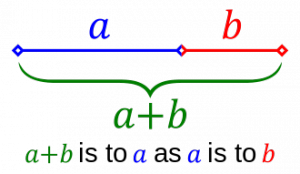Golden Ratio: Difference between revisions
No edit summary |
No edit summary |
||
| Line 2: | Line 2: | ||
In mathematics, two quantities are in the golden ratio if their ratio is the same as the ratio of their sum to the larger of the two quantities. The figure on the right illustrates the geometric relationship. | In mathematics, two quantities are in the golden ratio if their ratio is the same as the ratio of their sum to the larger of the two quantities. The figure on the right illustrates the geometric relationship. | ||
Phi is also used as a symbol for the [[Golden Ratio]] and on other occasions in math and science. This use is separately encoded as the Unicode glyph ϕ. | [[Phi]] is also used as a symbol for the [[Golden Ratio]] and on other occasions in math and science. This use is separately encoded as the Unicode glyph ϕ. | ||
The | The [[Golden Ratio]] 1.618033988749894848204586834... in mathematics, art, and architecture. | ||
The | The [[Golden Ratio]] also is called the golden mean or golden section. Other names include extreme and mean ratio, medial section, divine proportion, divine section , golden proportion, golden cut, and golden number.<ref>[http://en.wikipedia.org/wiki/Golden_ratio]</ref> | ||
The term " | The term "[[Phi]]" was coined by American mathematician Mark Barr in the 1900s. Phi has continued to appear in mathematics and physics, including the 1970s Penrose Tiles, which allowed surfaces to be tiled in five-fold symmetry. In the 1980s, phi appeared in quasi crystals, a then-newly discovered form of matter. | ||
==Golden Ratio in Renaissance Art== | ==Golden Ratio in Renaissance Art== | ||
Revision as of 18:35, 24 January 2016
In mathematics, two quantities are in the golden ratio if their ratio is the same as the ratio of their sum to the larger of the two quantities. The figure on the right illustrates the geometric relationship.
Phi is also used as a symbol for the Golden Ratio and on other occasions in math and science. This use is separately encoded as the Unicode glyph ϕ.
The Golden Ratio 1.618033988749894848204586834... in mathematics, art, and architecture.
The Golden Ratio also is called the golden mean or golden section. Other names include extreme and mean ratio, medial section, divine proportion, divine section , golden proportion, golden cut, and golden number.[1]
The term "Phi" was coined by American mathematician Mark Barr in the 1900s. Phi has continued to appear in mathematics and physics, including the 1970s Penrose Tiles, which allowed surfaces to be tiled in five-fold symmetry. In the 1980s, phi appeared in quasi crystals, a then-newly discovered form of matter.
Golden Ratio in Renaissance Art
In 1509, Luca Pacioli wrote a book that refers to the number as the "Divine Proportion," which was illustrated by Leonardo da Vinci. Da Vinci later called this sectio aurea or the Golden section. The Golden ratio was used to achieve balance and beauty in many Renaissance paintings and sculptures. Da Vinci himself used the Golden ratio to define all of the proportions in his Last Supper, including the dimensions of the table and the proportions of the walls and backgrounds. The Golden ratio also appears in da Vinci's Vitruvian Man and the Mona Lisa. Other artists who employed the Golden ratio include Michelangelo, Raphael, Rembrandt, Seurat, and Salvador Dali.[2]
Golden Ratio in Nature
The Golden ratio also appears in all forms of nature and science. Some unexpected places include:
- Flower petals: The number of petals on some flowers follows the Fibonacci sequence. It is believed that in the Darwinian processes, each petal is placed to allow for the best possible exposure to sunlight and other factors.
- Seed heads: The seeds of a flower are often produced at the center and migrate outward to fill the space. For example, sunflowers follow this pattern.
- Pinecones: The spiral pattern of the seed pods spiral upward in opposite directions. The number of steps the spirals take tend to match Fibonacci numbers.
- Sunflower seeds: Sunflower seeds grow in Fibonacci spirals.
- Tree branches: The way tree branches form or split is an example of the Fibonacci sequence. Root systems and algae exhibit this formation pattern.
- Shells: Many shells, including snail shells and nautilus shells, are perfect examples of the Golden spiral.
- Spiral galaxies: The Milky Way has a number of spiral arms, each of which has a logarithmic spiral of roughly 12 degrees. The shape of the spiral is identical to the Golden spiral, and the Golden rectangle can be drawn over any spiral galaxy.
- Hurricanes: Much like shells, hurricanes often display the Golden spiral.
- Fingers: The length of our fingers, each section from the tip of the base to the wrist is larger than the preceding one by roughly the ratio of phi.
- Animal bodies: The measurement of the human navel to the floor and the top of the head to the navel is the Golden ratio. But we are not the only examples of the Golden ratio in the animal kingdom; dolphins, starfish, sand dollars, sea urchins, ants and honeybees also exhibit the proportion.
- DNA molecules: A DNA molecule measures 34 angstroms by 21 angstroms at each full cycle of the double helix spiral. In the Fibonacci series, 34 and 21 are successive numbers.


